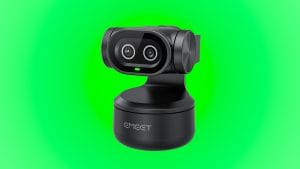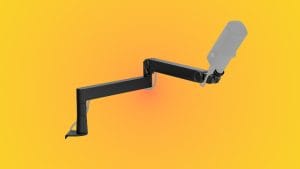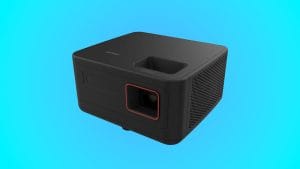Logitech MX Master 4 Wireless Productivity Mouse
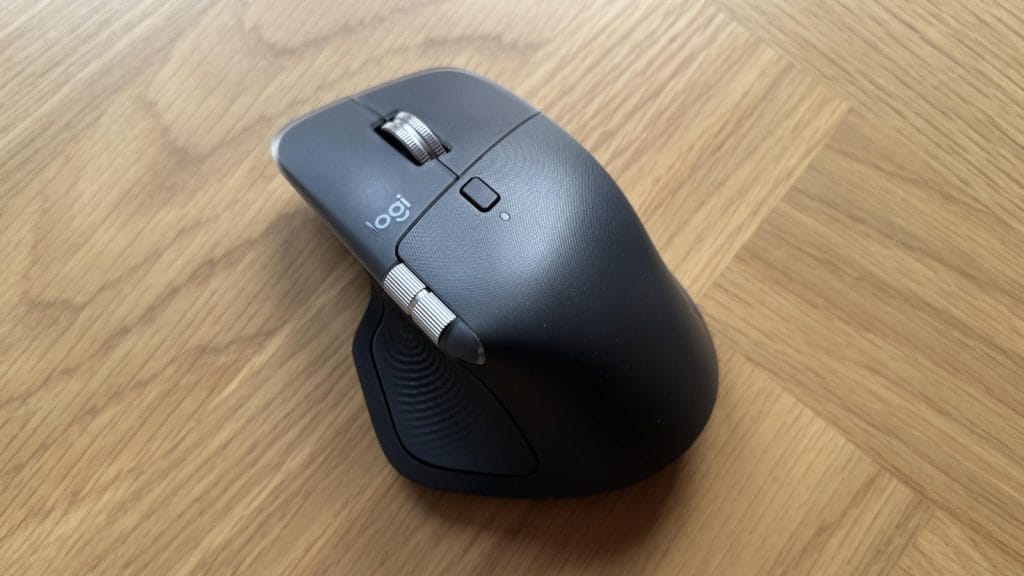
design
Let’s be honest, if you’ve seen an MX Master before, you’ve essentially seen the Logitech MX Master 4. This isn’t a criticism, though. The ergonomic shape, the sculpted thumb rest, the distinctive silhouette – it’s all present and correct. Logitech knows what works, and they’re not about to radically mess with a winning formula. But place the MX Master 4 side by side with a 3S, and the differences reveal themselves and become rather more obvious.
At 150g versus the 3S’s 141g, the MX Master 4 doesn’t seem that much heavier on paper. In your hand though it feels considerably more substantial, it’s actually a surprisingly heavy-feeling mouse. I’m sure I’m more sensitive to it, I’ve been using the 3S for the better part of two years, but even after a couple of weeks with the Master 4, that extra heft makes itself known. It’s not unpleasant, but it’s certainly noticeable and may be too much for some people.

The material changes are where Logitech’s made the most sensible decisions. Gone is the rubberized coating that covered most of the 3S’s upper shell. Instead the MX Master 4 swaps this for a lightly textured hard plastic across the top, with silicone reserved for the thumb rest and side. It looks premium though personally I think the hand feel of the 3S is slightly nicer against your palm. This is more a practical change however and it’s one that I can get behind. As comfortable as the coating of the 3S was, it was prone to showing its use. Shiny patches where my fingers sit and a gradual build up of day-to-day gunk means after a couple of years the 3S looks decidedly used. The Master 4 on the other hand? Sure, I’m only around a month in but it still looks box-fresh and I expect it to stay that way far longer.
On the underside, three large PTFE feet glide smoothly across both the laminate desk surface of the SmartDesk, a classic mouse mat, and the microfibre mat of my Secretlab MAGNUS Pro. Logitech also made the somewhat surprising, but entirely welcome, decision to leave the screws visible and accessible rather than hiding them under the feet – a repairability boost that’s very welcome in 2025. There’s also a power switch and a device switching button that supports three devices, as before.
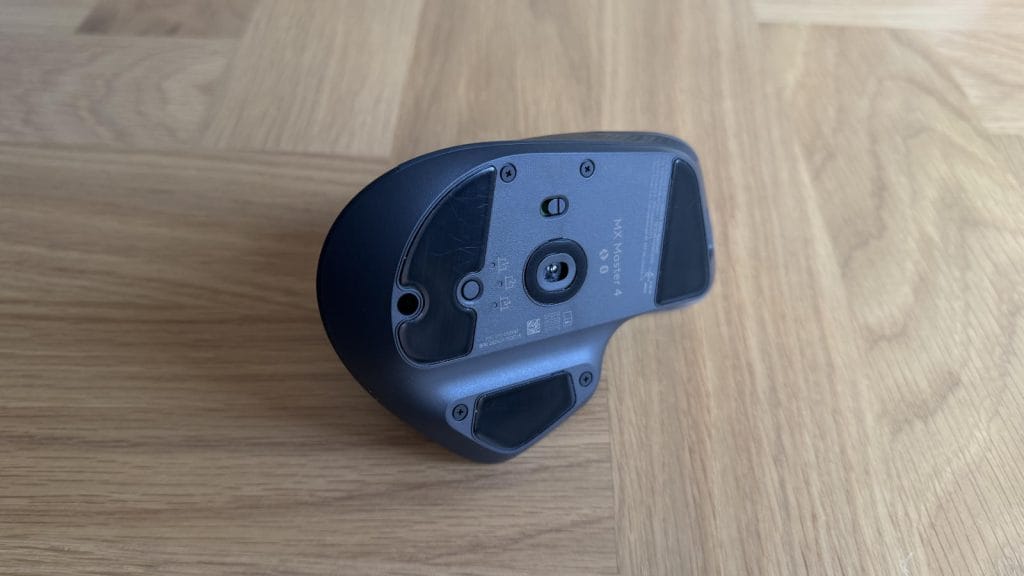
In the box you’ll find the mouse, a USB-C Logi Bolt receiver (another change from the 3S that relied on USB-A), and… that’s it. No charging cable this time. Given how many USB-C cables I already have lying around, I’m not particularly bothered, though it does feel slightly cheeky at this price point. There’s no dedicated storage spot for that Bolt receiver, though it’s small enough that it’ll fit in the MX Master 4’s own USB-C charging point.
performance
We’ll jump straight into the headline feature of the Logitech MX Master 4, it’s the main differentiator and the one Logitech’s marketing department is most excited about: haptic feedback. Much like a game controller or your phone, there’s a small motor built into the thumb rest that provides subtle tactile vibrations at various points. Pair the mouse, feel a buzz. Switch devices, another little tap. Use the Actions Ring, rumble. Low battery warning? Vibration. Is it useful? I’m not convinced. The haptics themselves feel pleasant enough, they’re smooth and feel premium, but I’m just not sure they deliver much actual benefit.
The MX Master 3S had its own hidden button in the thumb rest but it’s now far more prominent on the Logitech MX Master 4. If you’re used to that kind of action it’s far easier to access naturally than the old placement, though in testing I think I used it more times accidentally than I did on purpose. There is a decent amount of resistance so it’s not a design flaw I’m constantly mis-firing off particularly, it’s just after a fortnight of trying to integrate this into my workflow, I’ve ended up basically ignoring it. That’s likely a personal thing – I’m a writer so I’ve got muscle memory for keyboard shortcuts that’s hard to break.
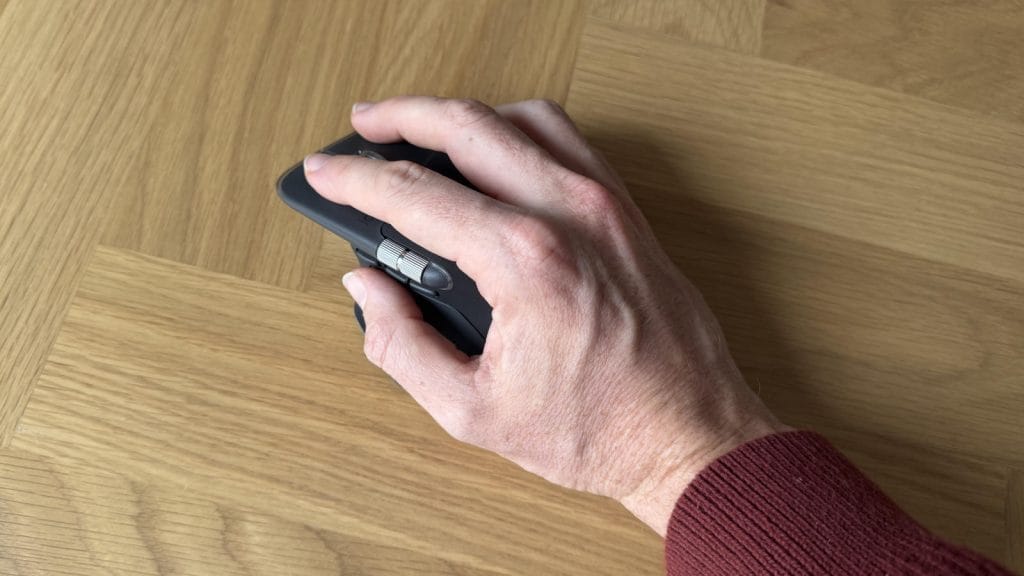
The Actions Ring triggered by the button is clever in concept: press the thumb button, and a radial menu appears around your cursor with customizable shortcuts. In supported apps like Photoshop, Lightroom, and DaVinci Resolve, you can quickly access tools and filters. For everything else, you can program it to open apps, adjust volume, lock your computer – general system-level stuff. It’s quite slick actually, if you can get in the habit of using it and invest the time to dial it in. I was slightly disappointed to see a lack of integration with other Logitech gear though. I use a Litra Beam on my desk and despite it being in the same Logi Options+ app, there’s no ability to add basic controls for the light to the Smart Actions. Technically that’s a failing of the app not the mouse, but it highlights a potential limitation of the Actions Ring and button.
Logitech says the clicks on the MX Master 4 are 90% quieter than the original MX Master 3, and even compared to the already-quiet 3S, there’s a clear improvement. The left and right clicks aren’t quite fully silent, but they’re near enough for most people day to day. The scroll wheel is quieter too, particularly in ratchet mode, and the free-spin MagSpeed scrolling remains delightfully smooth and near-silent. The thumb scroll wheel has moved slightly higher up and is now much more exposed. It’s a better placement than its predecessor and easier to reach without contorting your thumb.
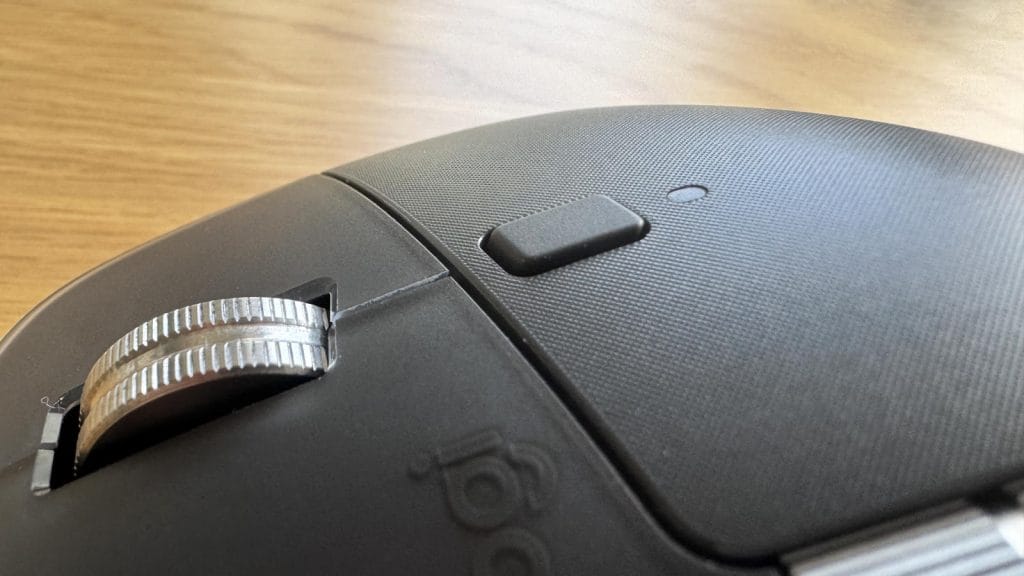
The sensor will likely ruffle a few feathers, understandably. Logitech has opted for the same 8,000 DPI Darkfield unit from the 3S, which is more than 15 years old at this point. It’s an impressive sensor that’s done a wonderful job over the years, it tracks brilliantly on virtually any surface, including glass, but it’s limited to just 125Hz. Now, Logitech will tell you this is a productivity mouse, not a gaming mouse, and 125Hz is perfectly adequate for office work. It’s right, really, if you’re working on a 60Hz display, doing spreadsheets and word processing, you probably won’t notice.
But if you’ve got a higher refresh rate monitor, something becoming increasingly common in office setups, the cursor loses that buttery smoothness and gains a slight jank as it moves. It’s not unusable, but it’s noticeable, particularly if you’re dragging windows or tracking fine details. On my 165Hz display, I can see it and it’s a shame, frankly, because everything else about the Logitech MX Master 4 feels buttery smooth.
Battery life remains at 70 days on a full charge, with a quick one-minute charge providing three hours of use, and connectivity options are Bluetooth 5.1 or the included Logi Bolt USB-C receiver. I tested across both and honestly didn’t notice a difference for day-to-day work. With either option I didn’t experience any dropouts or lag, though I also didn’t have any issues with my 3S in the same setup. The device switching feature works well and I was pleased by how quickly the connection would resume having switched from one machine to another. If you are hopping between devices however there is one significant omission: there’s no onboard memory. All your button mappings, Actions Ring configurations, and customizations live in the Logi Options+ software rather than on the MX Master 4 itself. That means you’ll need the app installed and set up on every machine you use.
summed up
The Logitech MX Master 4 is fundamentally an excellent productivity mouse, that almost wasn’t up for debate here. Building off something as good as the 3S it was unlikely to suddenly become anything other than great. The material improvements are welcome and should age better, and the quieter clicks are a nice quality-of-life upgrade if you work in shared spaces. The build quality is spot-on again, the ergonomics remain nicely considered, and it still tracks on any surface you throw at it. It all sounds mighty positive.
But is it worth £119.99 when you can get the 3S for 30-40% less? And has it done enough to move forward in 2025? Probably not.
Don’t get me wrong – the Logitech MX Master 4 is still one of the best productivity mice you can buy, this is far from a backwards step from Logitech. But after a month with it, I keep thinking about what could have been if Logitech had been slightly braver. Surely it’s time for a new sensor, and onboard memory feels like a no brainer. Instead, it vibrates. Which is fine, I suppose, if you’re into that sort of thing.








